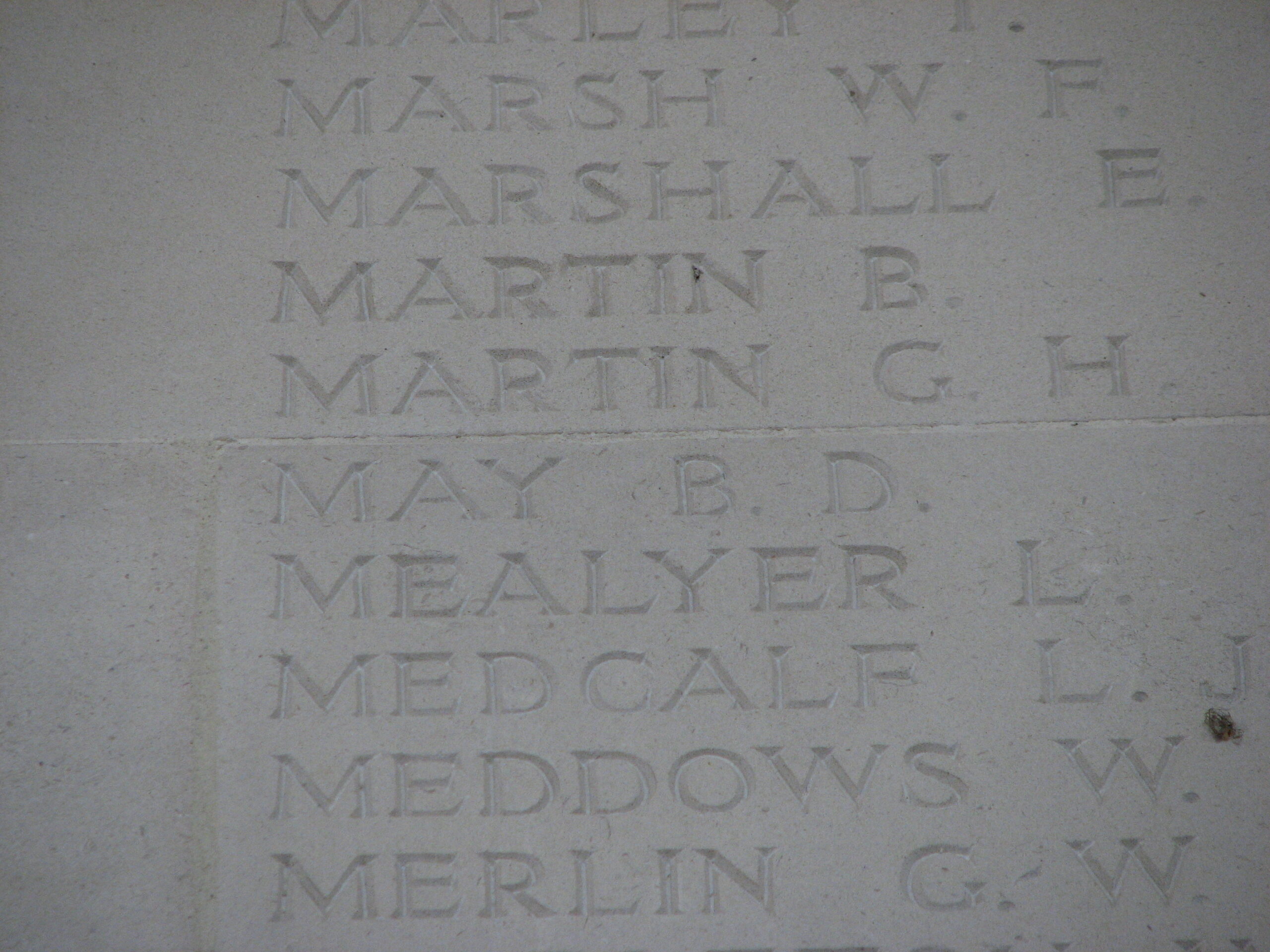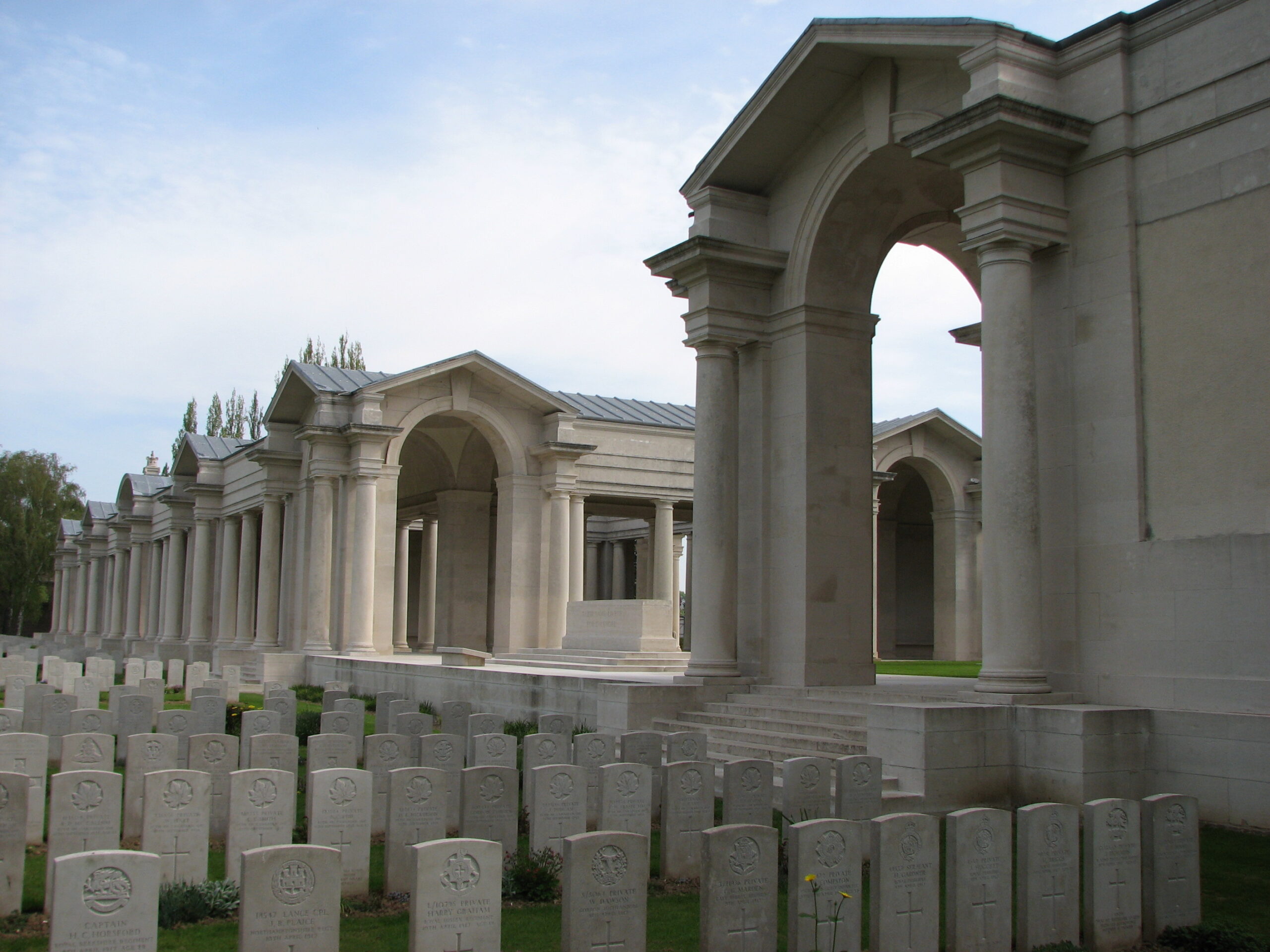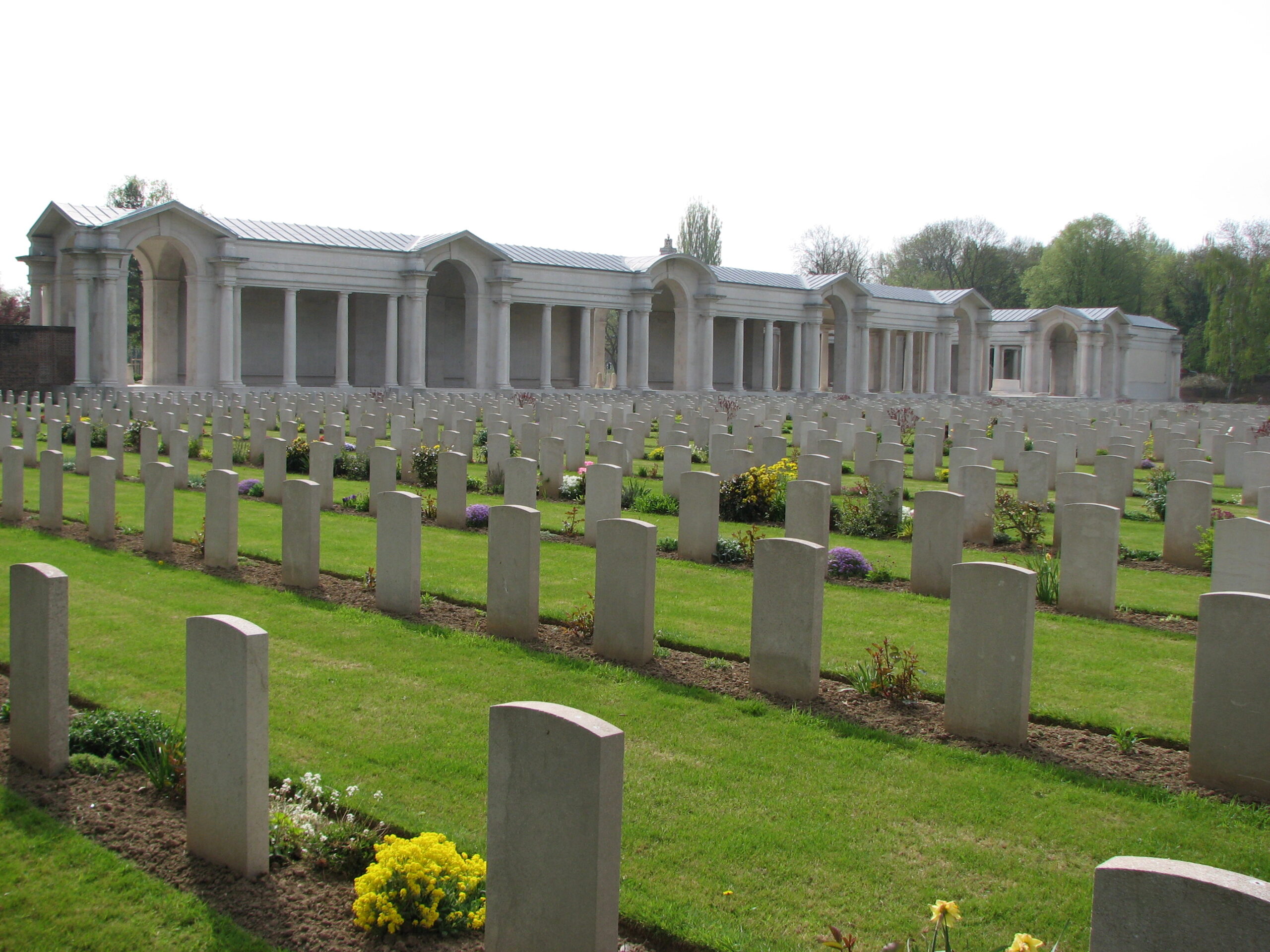Bertie May (1889 - 1918)
Bertie was wounded during the Battle of the Somme in 1916, and was later one of four Bergholt men killed during the German Spring Offensives of 1918.
- 43
- Died in the Great War
- 51.978384, 1.021513
Details
| Name: | Bertie David May |
| Service: | British Army |
| Unit: | 23rd Battalion, Middlesex Regiment |
| Regimental Number: | G/29002 |
| Rank: | Private |
| Date of Death: | 24th March 1918 |
| Age: | 28 |
| Commemorated: | Bay 7, Arras Memorial, Arras, France |
Family Background and Early Life
Bertie May was born in East Bergholt on 24th May 1889, most likely at his parents’ cottage near to the “Hare and Hounds” public house.
Bertie’s father, David was a Farm Labourer, who had lived in the village since he was a child, though he may have been born in Capel St. Mary. David had married an East Bergholt girl, Sarah Parker in 1870, and together they would have 12 children (four of whom died in infancy).
Less than 3 months after Bertie’s birth, his father died, possibly of a stroke. Sarah never remarried.
Bertie started at the village school at Burnt Oak in June 1893, just after his fourth birthday, and remained as a pupil there until April 1903. After leaving school, Bertie – like a large proportion of the male population of the village in that era – became a Farm Labourer.
The April 1911 Census, shows Bertie living with his widowed mother, and 5 of his elder brothers near the “Hare and Hounds” in a 6 room cottage.
Army Service 1915 – 1918
Unfortunately, Bertie’s Service Record was one of those destroyed in German bombing in 1940, so we can no longer be absolutely certain of many aspects of his Army Service.
The surviving evidence indicates that Bertie almost certainly joined the Army under what is commonly called the Derby Scheme in November or December 1915. Officially called the Group Scheme, this was effectively a last ditch attempt by the government to increase recruitment by voluntary means, before they had to resort to conscription. 1 Often called the Derby Scheme, after Lord Derby the Director-General of Recruiting. It permitted a man to enlist and then – if they chose to – be immediately transferred temporarily to the Army Reserve, and go back to his civilian occupation until he was formally required. The evidence suggests that Bertie chose not to take this option, but instead opted for immediate service.
In the middle of May 1916, Bertie was posted to The Duke of Cambridge’s Own (Middlesex Regiment) – it is possible that this may have occurred upon his arrival in France to join the British Expeditionary Force, but it is more likely that this was a domestic posting and that he was not sent to France until August of 1916.
We know that whilst he was abroad Bertie served variously with 3 different battalions of the Middlesex Regiment, the first of which was the 12th Battalion. Bertie was wounded in late September of 1916, during the Battle of the Somme, possibly when the 12th Battalion took part in the final capture of Thiepval village.
Surviving documents show that after his posting to the 12th Battalion, Bertie then served with the Regiment’s 17th Battalion before finally being transferred to the 23rd Battalion. Unfortunately we do not know exactly when these postings occurred except that the 17th Battalion was disbanded in France in February 1918, and that Bertie was certainly with the 23rd Battalion by late March of that year. 2 One of the officers in the Battalion at this time was 2nd Lieutenant Walter Tull, a pre-war professional footballer. He is perhaps best known today for being one of the first people of mixed ethnic background to play in the top division of the Football League, and also for being one of the first mixed heritage officers in the British regular army. Walter Tull was killed in action whilst serving with the 23rd Middlesex on 25th March 1918, the day after Bertie.
The 23rd Battalion was part of the 41st Division which had been transferred to Italy in November 1917, as part of The Italian Expeditionary Force (I.E.F.). Whether Bertie served with the 23rd Middlesex in Italy is not known. 3 The Italian Army had recently suffered a major defeat at the hands of the Austrians and Germans at the Battle of Caporetto, which threatened the collapse of the whole Italian Front. In response to this, the British and French organised a joint military force which was sent to reinforce the Italians.
The British I.E.F. originally consisted of 5 divisions, but 2 of these returned to France in March and April 1918, after the Italian Front had been stabilised. The 41st Division – including the 23rd Middlesex – were one of those returned to France.
The Battalion left Italy at the start of March 1918, and were back in France just before the Germans launched the first in a series of massive offensives.
German Spring Offensive
The British Expeditionary Force (B.E.F.), were suffering from a manpower crisis and low morale following the heavy fighting and limited success of the previous year. In contrast, the German Army on the Western Front had received a massive influx of manpower, having been able to transfer many divisions from the Eastern Front where the Russians had signed an Armistice in December.
The Germans seized this opportunity to break the stalemate on the Western Front and tried to destroy the B.E.F., knock the British out of the war, and in the process hopefully make the French sue for peace before the United States brought in increasing numbers of troops.
The British knew that an attack was coming, but they did not know where. The Germans launched their offensive in the early hours of 21st March 1918. 65 German divisions launched a massive onslaught against 26 weakened British divisions along a 50 mile front running roughly from Arras in the north to La Fere in the South.
On the day that the offensive was launched the 23rd Middlesex were still en-route to where their division was taking over the line, east of the town of Bapaume. By the end of the day, the Germans had advanced up to 10 miles in places. The British had suffered tremendous casualties – including large numbers who had been captured – and were engaged in a desperate battle to stop the retreat becoming a rout.
By the afternoon of the 22nd March, the Battalion were approximately 5 miles north-east of Bapaume, and were about to be committed to the battle, as part of an attempt to stem the German advance in that sector. The Regimental History describes what happened next:
“At 3.30 pm lorries carried the Battalion to a monument (just west of Favreuil) on the Arras-Bapaume road where, in a field, the Middlesex bivouacked until midnight.
At 12.15 a.m. on the 23rd companies marched off via Fremicourt to Beugny where support positions in front of the latter village were taken up. By dawn the Battalion was disposed in shelters or hastily dug trenches.
At 10.30 a.m. Beugny and the neighbourhood were subjected to a regular tornado of shells and the 23rd Middlesex had numerous casualties. The enemy’s infantry, in great strength, then advanced to the attack and drove in the advanced battalions. The Middlesex, in order to conform to the line on their flanks, fell back west of Beugny to a new line (the Green Line) astride the Beugny-Fremicourt road. “D” Company covered the retirement of the other companies.
That night the 23rd were relieved, and moved back to the aerodrome at Favreuil, having lost throughout the day 4 other ranks killed, 39 wounded and 12 missing…
Meanwhile the 23rd Middlesex, of the 123rd Brigade, 41st Division, who, on the night of 23rd March, had bivouacked near the aerodrome at Favreuil, had again been engaged with the enemy.
At 11.30 a.m. on the 24th, the 23rd Battalion took up positions in the reserve line near Favreuil and in the rear of Hun Dump. Late in the afternoon the troops in the front line began to fall back and retired to the reserve line, where they were reorganised and put into the reserve line in the sector occupied by the Middlesex. At 9.p.m. a new line was taken up at the Monument (on the Bapume-Sapignies road), where the Battalion, assisted by some Royal Engineers, dug in until dawn. No description of any fighting on the 24th is given in the Battalion Diary, but the casualty list tells its own story. The losses on that day were 13 other ranks killed, 57 wounded, 6 missing, 6 missing believed killed, 22 missing believed wounded” 4 From “The Die Hards in the Great War” by Everard Wyrrell, Harrison & Sons, 1926. 5 According to Commonwealth War Graves records show that the Battalion actually lost 28 men in the fighting on the 24th March.
Bertie was one of those killed in the fighting on the 24th. He was 28 years old.
Like the vast majority of from the Battalion who died on 24th March, Bertie has no known grave. He is officially commemorated in Bay 9 of the Arras Memorial. 6 Almost 37,000 Commonwealth service personnel died in France during Operation Michael – the first of the German Spring Offensives. Nearly two thirds of those have no known grave. (Source Commonwealth War Graves Commission)
Copyright © Mark Ashmore, 2024
- 43
- Died in the Great War
- 51.978384, 1.021513




